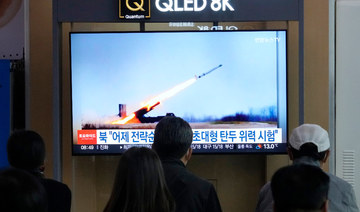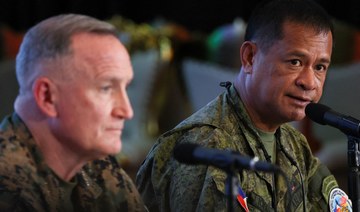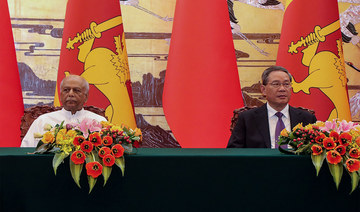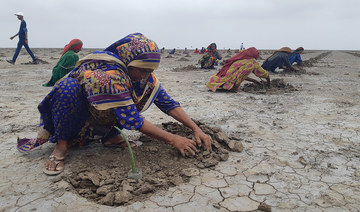LONDON: Political and business leaders will meet at the Swiss resort of Davos next week for the World Economic Forum, where issues from geopolitical instability to climate change are on the agenda.
Yet as they seek consensus and solutions for global challenges, environmental campaigners argue that their travel arrangements may prove more significant — as hundreds of attendees are set to arrive by high-polluting private jets.
During last year’s week-long event, 1,040 private planes flew in and out of airports serving the resort of Davos, found a new report commissioned by campaign group Greenpeace.
Those flights caused four times more planet-heating carbon dioxide (CO2) emissions than during an average week — equivalent to the emissions of 350,000 cars, the report found.
“For a forum where people actually claim to solve climate issues ... it seems quite hypocritical,” said Klara Maria Schenk, transport campaigner at Greenpeace Europe.
But it’s not just Davos. Private jet use by the super-rich and political leaders is increasingly fueling public outrage.
Pop star Taylor Swift has faced criticism for her jetsetting habits, while British Prime Minister Rishi Sunak recently came under fire for taking a 36-minute domestic flight in England.
So what is the impact of private jets on the environment, and what do experts think could be done in response?
How polluting are private jets?
A private jet can emit two tons of carbon dioxide in an hour — which is equivalent to a few months of an average person’s greenhouse gas emissions in the European Union, according to the European NGO Transport & Environment (T&E).
Private planes are between five and 14 times more polluting than commercial jets per passenger, and 50 times more than high-speed rail, according to T&E data.
“If you break it down by passenger and kilometer, it is actually the most polluting way to travel in existence,” Schenk of Greenpeace said in an interview.
At Davos last year, more than half of the flights traveled less than 750km, and the shortest flight recorded was only 21km, the Greenpeace research found.
“Many of these flights would be replaceable by a few hours of train ride,” Schenk added.
What does that mean for climate change?
The aviation sector accounts for about 2.8 percent of global CO2 emissions. While that proportion seems relatively minor, experts point to the outsized impact caused by a small number of people.
Just 1 percent of the global population is responsible for 50 percent of the CO2 emitted by commercial aviation, according to a 2020 study in the Global Environmental Change journal.
“Frequent flyers and private jet users are by far the worst offenders when it comes to aviation emissions,” said Denise Auclair, corporate travel campaign manager at T&E.
Private jets are “emblematic” of the climate crisis as “people who are not flying, not contributing to the problem are suffering the effects,” like droughts and wildfires, she said.
How popular are private jets?
Despite concerns over their climate impact, private planes have become more and more popular in recent years.
While celebrities from US media personality Kylie Jenner to Tesla and Twitter CEO Elon Musk have made the headlines, with their private flights tracked and published on social media, the trend is also becoming more common in wider business travel.
Private jet travel “started booming” during the COVID-19 pandemic, when most commercial flights were grounded, said Schenk from Greenpeace.
“While we were sitting at home, these people flew in their private jets,” she said.
In the United States, private business jets now account for a quarter of all flights, approximately twice their pre-pandemic share, according to aviation consultancy WINGX.
Can air travel become sustainable?
The airline industry has said sustainable aviation fuels can help it reach net zero by 2050. The International Air Transport Association (IATA) says these fuels can reduce emissions by up to 80 percent during their lifecycle compared to conventional fuel.
Meanwhile, airlines such as Air Canada and US carrier United Airlines have been buying electric planes earmarked for short trips.
Yet environmental groups say that an increase in sustainable fuels could lead to deforestation as vast amounts of lands are cleared to grow bioenergy crops such as palm and soy oils.
There are also concerns about how long it would take for these cleaner fuels to be used at scale — which made up less than 0.1 percent of aviation fuels in 2021, according to the International Energy Agency.
“We have to admit to ourselves ... sustainable fuels are not going to get us on the decarbonization path that we need to be on today,” said Auclair of T&E.
She said a combination of measures will be needed to accelerate emissions reductions over the next decade, including a rethink of what kind of flights are really necessary.
What are governments doing about it?
Governments in Europe have started to explore steps to reduce private jet flights, and encourage passengers to take cleaner forms of transport.
In December, France won approval from the European Commission to ban short-haul flight routes of less than two-and-a-half hours for which there are direct rail options.
Belgium, meanwhile, will impose new taxes on private jets and short-haul flights from April.
Auclair said taxes could provide an incentive to reduce air travel while funding the acceleration of sustainable aviation developments.
She also said corporate leaders need to set targets and create clear travel policies as part of their climate plans.
“If you’re saying as a leader that your organization is taking steps to address climate change, then it just doesn’t really make sense for you to be taking a private jet to Davos,” Auclair said. “We need to get serious.”
EXPLAINER: As leaders fly to Davos, how do private jets affect the climate?
https://arab.news/64xdm
EXPLAINER: As leaders fly to Davos, how do private jets affect the climate?

- During last year’s week-long event, 1,040 private planes flew in and out of airports serving the resort of Davos
Fake videos of Modi aides trigger political showdown in India election

- Indian police arrest nine people for circulating fake video of Indian Home Minister Amit Shah
- With more than 800 million Internet users, tackling misinformation in India is a huge challenge
BENGALURU/LUCKNOW: Manipulated videos are taking center stage as campaigning heats up in India’s election, with fake clips involving two top aides of Prime Minister Narendra Modi triggering police investigations and the arrest of some workers of his rival Congress party.
In what has been dubbed as India’s first AI election, Modi said last week fake voices were being used to purportedly show leaders making “statements that we have never even thought of,” calling it a conspiracy “to create tension in society.”
Indian police — already investigating the spread of fake videos showing Bollywood actors criticizing Modi — are now investigating a doctored online clip that showed federal home minister Amit Shah saying the ruling Bharatiya Janata Party will stop certain social guarantees for minorities, a subject sensitive for millions of voters.
Shah retorted on X, posting his “original” and the edited “fake” speech and alleging — without providing any evidence — that the main opposition Congress was behind the video it created to mislead the public. The minister said “directions have been issued to the police to address this issue.”
Indian police arrested at least nine people, including six members of Congress’ social media teams, in the states of Assam, Gujarat, Telangana and New Delhi last week for circulating the fake video, according to police statements.
Five of the Congress workers were released on bail, but the most high-profile arrest made by the cybercrime unit of New Delhi police came on Friday, when they detained a Congress national social media coordinator, Arun Reddy, for sharing the video. New Delhi is one region where Shah’s ministry directly controls police. Reddy has been sent into three-day custody.
The arrest has sparked protests from Congress workers with many posting on X using the #ReleaseArunReddy tag. Congress lawmaker Manickam Tagore said the arrest was an example of “authoritarian misuse of power by the regime.”
Congress’ head of social media, Supriya Shrinate, did not respond to messages and an email seeking comment.
MISINFORMATION
India’s election from April 19 to June 1 will be the world’s largest democratic event. With nearly a billion voters and more than 800 million Internet users, tackling the spread of misinformation is a high stakes job. It involves round-the-clock monitoring by police and election officials who often issue take down orders to Facebook and X as investigations start.
In India’s most populous state of Uttar Pradesh, more than 500 people keep tabs on online content, flagging controversial posts and coordinating with social media companies for their removal when needed, police chief Prashant Kumar told Reuters on Saturday.
Another fake video that sparked a storm last week showed Yogi Adityanath, the state’s chief minister, criticizing Modi for not doing enough for families of those who died in a 2019 militant attack. Though fact checkers said the video was created using different parts of an original clip, state police called it an “AI generated, deepfake.”
Using Internet address tracking, state police arrested a man named Shyam Gupta on May 2 who had shared the fake video post on X a day earlier, receiving over 3,000 views and 11 likes.
The police have accused Gupta of forgery and promoting enmity under Indian law provisions that can carry a jail term of up to seven years if convicted. Reuters could not reach him as he is currently serving a 14-day custody period.
“This person is not a tech guy. Had he been tech savvy, arresting him quickly would not have been possible,” said police officer Kumar.
Australian police shoot boy dead after stabbing with ‘hallmarks’ of terrorism
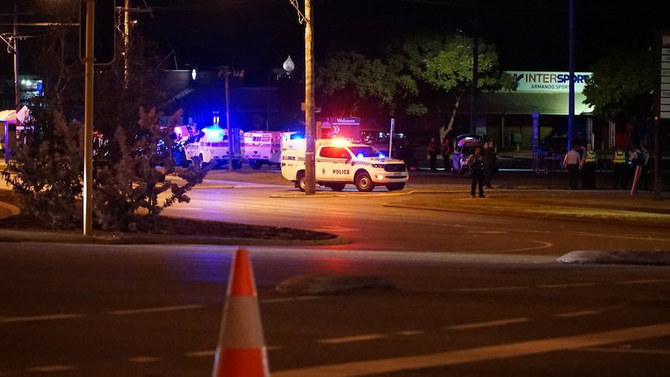
SYDNEY,: Australian police said on Sunday they had shot dead a boy after he stabbed a man in Western Australia’s capital Perth, in an attack authorities said indicated terrorism.
There were signs the 16-year-old, armed with a kitchen knife, had been radicalized online, state authorities said, adding they received calls from concerned members of the local Muslim community before the attack, which occurred late on Saturday night.
The attack, in the suburb of Willetton, had “hallmarks” of terrorism but was yet to be declared a terrorist act, police said.
“At this stage it appears that he acted solely and alone,” Western Australia Premier Roger Cook told a televised press conference in the state capital Perth, regarding the attacker.
The victim, stabbed in the back, was stable in hospital, authorities said.
Prime Minister Anthony Albanese said he had been briefed on the incident by police and intelligence agencies, which advised there was no ongoing threat.
“We are a peace-loving nation and there is no place for violent extremism in Australia,” Albanese said on social media platform X.
The incident comes after New South Wales police last month charged several boys with terrorism-related offenses in investigations following the stabbing of an Assyrian Christian bishop while he was giving a live-streamed sermon in Sydney, on April 15.
The attack on the bishop came only days after a stabbing spree killed six in the Sydney beachside suburb of Bondi.
Gun and knife crime is rare in Australia, which consistently ranks among the safest countries in the world, according to the federal government. (Reporting by Sam McKeith in Sydney; Editing by Christian Schmollinger and William Mallard)
North Korea’s UN ambassador says new sanctions monitoring groups will fail
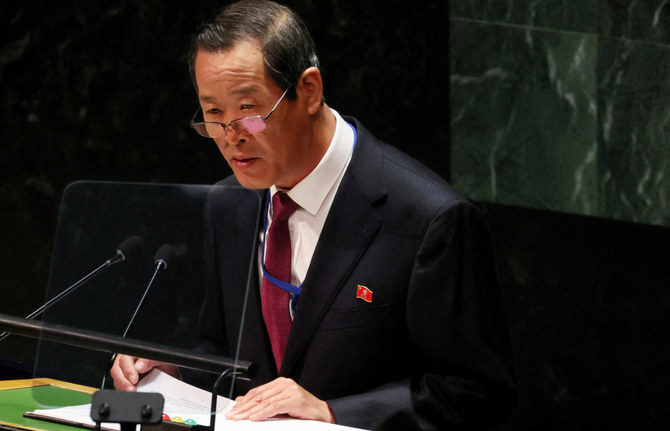
- Earlier this year, Russia vetoed the annual renewal of a panel of experts amid US-led accusations that North Korea has transferred weapons to Russia for use in its war in Ukraine
SEOUL: Efforts led by the US and other Western countries to form new groups to monitor sanctions on North Korea will fail, the country’s UN envoy said on Sunday, according to state media KCNA.
Ambassador Kim Song made the comment in response to a joint statement the US and its allies issued this week calling to continue the work of a UN panel of experts monitoring longstanding sanctions against Pyongyang for its nuclear weapons and missile programs.
Earlier this year, Russia vetoed the annual renewal of the panel amid US-led accusations that North Korea has transferred weapons to Russia for use in its war in Ukraine.
“The hostile forces may set up the second and third expert panels in the future but they are all bound to meet self-destruction with the passage of time,” KCNA quotes Kim as saying in a statement.
Last month, US Ambassador to the United Nations Linda Thomas-Greenfield visited the Demilitarized Zone, a heavily fortified border between the two Koreas, which remain technically at war and urged Russia and China to stop rewarding North Korea for its bad behavior.
Her trip came after Russia rejected the annual renewal of the multinational panel of experts that has over the past 15 years monitored the implementation of UN sanctions aimed at curbing North Korea’s nuclear and missile programs.
China publicizes for the first time what it claims is a 2016 agreement with Philippines

- The move threatens to further raise tensions in the disputed waterway, through which much of the world’s trade passes and which China claims virtually in its entirety
TAIPEI, Taiwan: For the first time, China has publicized what it claims is an unwritten 2016 agreement with the Philippines over access to South China Sea islands.
The move threatens to further raise tensions in the disputed waterway, through which much of the world’s trade passes and which China claims virtually in its entirety.
A statement from the Chinese Embassy in Manila said the “temporary special arrangement” agreed to during a visit to Beijing by former president Rodrigo Duterte allowed small scale fishing around the islands but restricted access by military, coast guard and other official planes and ships to the 12 nautical mile (22 kilometer) limit of territorial waters.
The Philippines respected the agreement over the past seven years but has since reneged on it to “fulfill its own political agenda,” forcing China to take action, the statement said.
“This is the basic reason for the ceaseless disputes at sea between China and the Philippines over the past year and more,” said the statement posted to the embassy’s website Thursday, referring to the actions of the Philippines.
President Ferdinand Marcos Jr. and Duterte have denied forging any agreements that would have supposedly surrendered Philippine sovereignty or sovereign rights to China. Any such action, if proven, would be an impeachable offense under the country’s 1987 Constitution.
However, after his visit to Beijing, Duterte hinted at such an agreement without offering details, said Collin Koh, senior fellow at the S. Rajaratnam School of International Studies based in Nanyang Technological University, Singapore and an expert on naval affairs in the Indo-Pacific region, particularly Southeast Asia.

“He boasted then that he not only got Chinese investment and trade pledges, but also that he secured Philippine fishermen access to Scarborough Shoal,” Koh said, referring to one of the maritime features in dispute.
Beijing’s deliberate wording in the statement “is noteworthy in showing that Beijing has no official document to prove its case and thus could only rely mainly on Duterte’s verbal claim,” Koh said.
Marcos, who took office in June 2022, told reporters last month that China has insisted that there was such a secret agreement but said he was not aware of any.
“The Chinese are insisting that there is a secret agreement and, perhaps, there is, and, I said I didn’t, I don’t know anything about the secret agreement,” said Marcos, who has drawn the Philippines closer to its treaty partner the US “Should there be such a secret agreement, I am now rescinding it.”
Duterte nurtured cozy relations with Chinese President Xi Jinping during his six-year presidency while openly being hostile to the United States for its strong criticism of his deadly campaign against illegal drugs.
While he took an almost virulently anti-American stance during his 2016 visit to Washington’s chief rival, he has said he also did not enter into any agreement with Beijing that would have compromised Philippine territory. He acknowledged, however, that he and Xi agreed to maintain “the status quo” in the disputed waters to avoid war.
“Aside from the fact of having a handshake with President Xi Jinping, the only thing I remember was that status quo, that’s the word. There would be no contact, no movement, no armed patrols there, as is where is, so there won’t be any confrontation,” Duterte said.
Asked if he agreed that the Philippines would not bring construction materials to strengthen a Philippine military ship outpost at the Second Thomas Shoal, Duterte said that was part of maintaining the status quo but added there was no written agreement.
“That’s what I remember. If it were a gentleman’s agreement, it would always have been an agreement to keep the peace in the South China Sea,” Duterte said.
House Speaker Ferdinand Martin Romualdez, Marcos’s cousin and political ally, has ordered an investigation into what some are calling a “gentleman’s agreement.”
China has also claimed that Philippine officials have promised to tow away the navy ship that was deliberately grounded in the shallows of the Second Thomas Shoal in 1999 to serve as Manila’s territorial outpost. Philippine officials under Marcos say they were not aware of any such agreement and would not remove the now dilapidated and rust-encrusted warship manned by a small contingent of Filipino sailors and marines.
China has long accused Manila of “violating its commitments” and “acting illegally” in the South China Sea, without being explicit.
Apart from China and the Philippines, Vietnam, Malaysia, Taiwan and Brunei also have overlapping claims in the sea that is rich in fishing stocks, gas and oil. Beijing has refused to recognize a 2016 international arbitration ruling by a UN-affiliated court in the Hauge that invalidated its expansive claims on historical grounds.
Skirmishes between Beijing and Manila have flared since last year, with massive Chinese coast guard cutters firing high-pressure water cannons at Philippine patrol vessels, most recently off Scarborough Shoal late last month, damaging both. They have also accused each other of dangerous maneuvering, leading to minor scrapes.
The US lays no claims to the South China Sea, but has deployed Navy ships and fighter jets in what it calls freedom of navigation operations that have challenged China’s claims.
The US has warned repeatedly that it’s obligated to defend the Philippines — its oldest treaty ally in Asia — if Filipino forces, ships or aircraft come under an armed attack, including in the South China Sea.
Japan seeks Sri Lanka recovery for regional stability
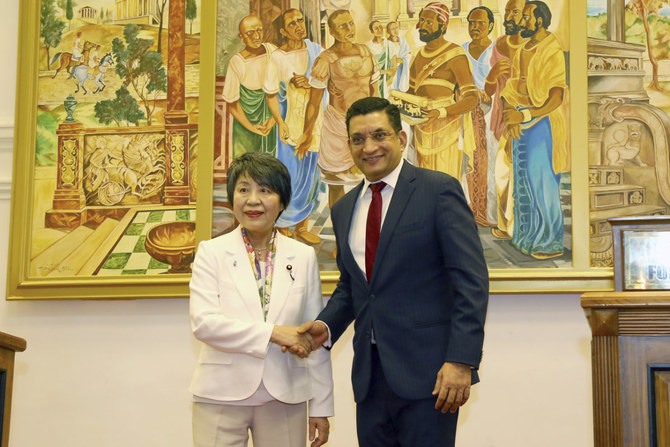
- Colombo has handed over to a Chinese firm a deep sea port built on a huge China loan after failing to pay
- Colombo defaulted on its $46 billion external debt in April 2022 and has failed to finalize any deals with foreign creditors so far
COLOMBO: Strategically placed Sri Lanka’s economic recovery was essential for stability in the Indo-Pacific region, Japan’s foreign minister said Saturday, urging Colombo to swiftly restructure its foreign debt.
Yoko Kamikawa said after talks with her Sri Lankan counterpart that Colombo should secure agreements with bilateral lenders and international sovereign bondholders to unlock suspended foreign funding.
The Sri Lankan government which defaulted on its $46 billion external debt in April 2022 had hoped to finalize deals with foreign creditors by April but there have been no final agreements yet.
Kamikawa said she “stressed the importance of reaching a debt restructuring agreement with all the creditors,” including China — the largest bilateral lender to the island.
“I also conveyed Japan’s intention to further support Sri Lanka’s development by swiftly resuming existing yen loan projects (after a debt restructuring deal),” she said.
She said Tokyo considered Colombo’s economic recovery as crucial for the entire region. The island is located halfway along the main east-west international shipping route.
“The restoration of stability and economic development of Sri Lanka, which is at a strategic location in the India Ocean, is essential for the stability and prosperity of the entire Indo-Pacific region,” she added.
Sri Lanka must secure agreement from all official creditors and a majority of private bondholders to continue with a four-year $2.9 billion bailout loan begun since March last year.
Japan, the second largest bilateral lender to the island has expressed concern about China’s big infrastructure projects in Sri Lanka and elsewhere in the region.
Tokyo maintains that the Chinese-funded projects did not meet international finance standards.
Unable to repay a huge loan taken from China in 2017 to build a deep sea port in southern Hambantota, Sri Lanka handed it over to a Chinese firm for $1.12 billion on a 99-year lease.
Sri Lanka ran out of cash to pay for even the most essential imports in 2022, leading to chronic shortages of food, fuel and medicines.
Then-president Gotabaya Rajapaksa, who faced allegations of mismanagement and corruption, was forced to flee the country and resign in July 2022 after months of protests.
His successor, Ranil Wickremesinghe has raised taxes, cut subsidies and is enforcing painful economic reforms in line with the IMF bailout.








